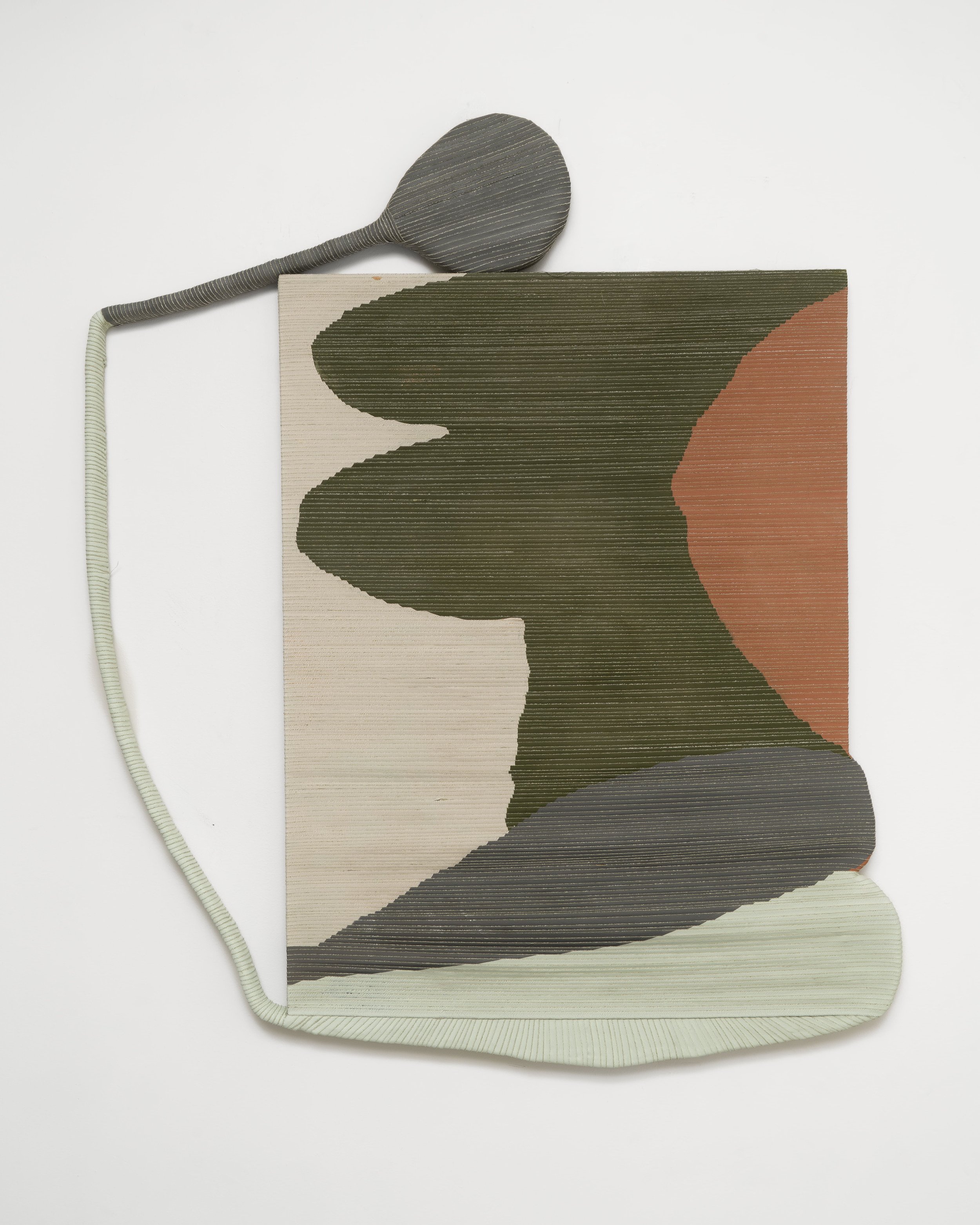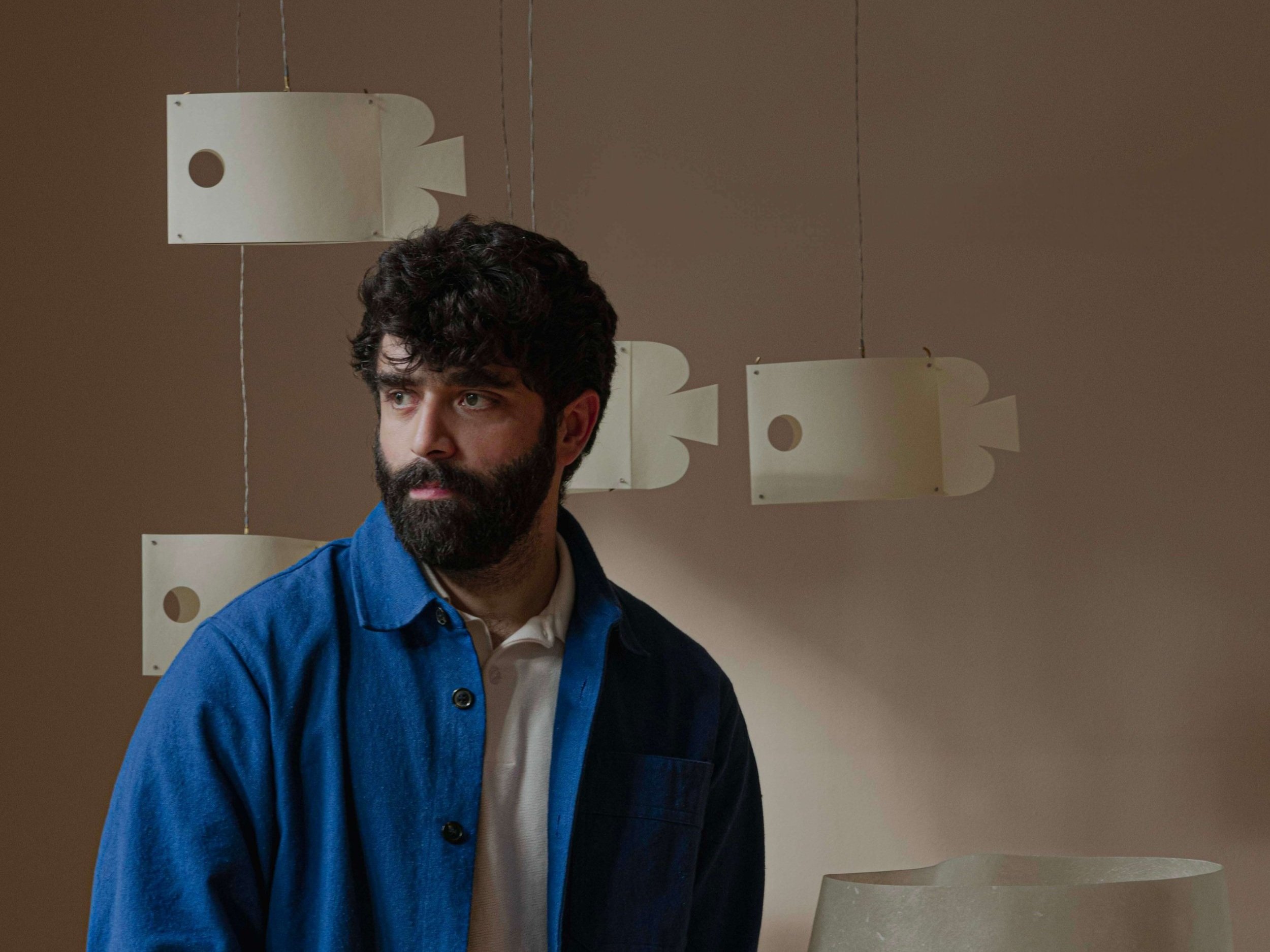Fabric of Expression: Jean Alexander Frater on Weaving and Painting
people • DESIGNERS
What happens when a painting is no longer confined to the frame? Jean Alexander Frater invites us into a practice where canvas becomes form—cut, woven, and reassembled into dimensional expressions. In this exclusive interview, the Chicago-based artist reflects on influences from Frank Stella to Katharina Grosse, the duality of structure and intuition, and how weaving artwork has reshaped her relationship to materiality. Discover how daily rituals, spatial installations, and deliberate constraints guide a language of art that’s both meditative and radically physical.
WEBSITE: alexanderfrater.com INSTAGRAM: @jeanalexanderfrater
Words: designeers
APRIL 2025
DESIGNEERS
Your work blurs the line between painting and sculpture. When did you first start questioning what a canvas could be?
Jean Alexander Frater
The turning point came when I began deconstructing paintings—literally taking them apart—to understand them differently. This exploration of canvas manipulation allowed me to view the surface as more than just a support for paint. I was equally fascinated by the conceptual and process art of the 1970s, as well as the shaped canvas and material painters from Frank Stella to Elizabeth Murray—both known for their innovations in material-driven art and shaped canvas exploration. In graduate school, my studio was adjacent to the Art Institute of Chicago, where I walked through every day, soaking in the works that shaped my visual language.
The two pivotal shifts that changed the trajectory of my work came from this place of curiosity and constraint. First, I moved the expressive gesture away from how the paint was applied and toward how the painted canvas itself was treated. Second, I started manipulating the canvas as the final gesture—folding, weaving, cutting—treating it not as a surface but as a sculptural material. That’s when everything opened up.
DESIGNEERS
There’s a strong physicality to your pieces—folded, woven, sculpted. Do you approach them with a plan, or is it an intuitive process?
Jean Alexander Frater
Both. My process always begins with painting on large pieces of canvas— much larger than the final work. Once I start folding, weaving, or layering, the sculptural painting takes form. The work becomes a piece of woven canvas art, where process and structure emerge intuitively. The initial plan usually involves a specific colour palette and an overall compositional idea. That gives me a loose structure to work within.
But improvisation is essential. It happens during the painting process and again when I begin to deconstruct and reassemble the surface. I tear up the painting, reconfigure it, and let the form guide the next steps. So while there’s a plan at the beginning, the piece really comes alive when the shape starts to grow out of the process itself. That’s where intuition takes over.
Figure in Recline Among the Ascension of Fruit
Escaping the Beauty Instrument
DESIGNEERS
Which living artist do you admire most, and what is it about their work that speaks to you?
Jean Alexander Frater
The answer to this question is always shifting—it evolves as I do—but I’m consistently stunned by the boldness and architectural presence in the work of Katharina Grosse, as well as the texture and subject matter in Caroline Achaintre’s fibre paintings. What draws me to both artists is how clearly they’ve carved out distinct, highly specific ways of making. Their practices are unmistakably their own. Grosse challenges and expands the boundaries of painting and installation through immersive, explosive gestures, while Achaintre merges fibre and painting in a way that feels both raw and deeply intentional. Each artist redefines their medium with a fearless sense of form and materiality—and that’s something I deeply respect and strive for in my own work.
DESIGNEERS
What’s next for you? Any new materials, collaborations, or creative directions you’re excited to explore?
Jean Alexander Frater
Right now, I’m especially excited about a large-scale project that will span several floors through a staircase. It’s essentially a painting in the round—very theatrical, immersive, and spatially ambitious. It challenges me to think about how a painting can unfold through movement and architecture. I’m also working on a new collection of pieces, which The Mission Projects will be featuring at the inaugural Untitled Art Fair in Houston this fall. It’s a thrilling moment to be pushing the boundaries of painting in both intimate and large-scale formats
DESIGNEERS
If you could only work with one material for the rest of your career, what would it be and why?
Jean Alexander Frater
For almost 20 years, I’ve limited my materials to just paint, canvas, and the rectangular frame—and I’ve found that these constraints have paradoxically opened up a space for infinite exploration. Rather than feeling restricted, I’ve discovered endless possibilities within these boundaries. They’ve become a framework through which I can experiment freely with form, gesture, structure, and space. I’m still constantly surprised by what can emerge.
Post Reclining
And The Shadows Make Three
“If I’m unsure of what to do or feel lost or blocked, I draw. I engage in automatic drawing, focusing on one idea per page. I move through ideas freely.”
Jean Alexander Frater
DESIGNEERS
What does your ideal studio day look like? Are there any rituals or habits that keep you in the creative flow?
Jean Alexander Frater
I arrive at the studio around 7:30 or 8:00 AM every day. I walk there when the weather is nice or if I need to shift my pace or change my mood. I always begin my day by working on a painting in some form—whether it’s painting, weaving, or drawing.
I dive right into it, getting to work immediately.
If I’m unsure of what to do or feel lost or blocked, I draw. I engage in automatic drawing, focusing on one idea per page. I take a stack of paper from my printer and just go with it, not overthinking. I move through ideas freely. Then, I stack the drawings up, set them aside, and look at them the next day. From there, I choose one to develop further into my next piece.
DESIGNEERS
What’s your favourite hotel in the world?
Jean Alexander Frater
The Austin Proper Hotel, designed by Kelly Wearstler, is my favourite. It’s rich, layered, and deeply textured—handwoven rugs, carved wood, velvet, ceramics, aged metals, and natural stone all coexist in a way that feels both luxurious and grounded. What I love most is how uniquely Austin it is. Wearstler captures the city’s creative, eclectic spirit with a lived-in elegance that feels curated but never overly polished. It’s a space that stays with you—artful, immersive, and full of subtle surprises.
Green Swooping Extensions
Floating Crouching
DESIGNEERS
Is there a space that’s left a lasting impression on you?
Jean Alexander Frater
The space that has left the deepest, most lasting impression on me is the Tadao Ando Room at the Art Institute of Chicago (Ando Gallery). I go there often. It’s become the destination at the end of a quiet ritual—walking from my studio through the city to the museum. The path itself is part of the experience: I pass through shifting neighbourhoods where my gaze drops to sidewalk cracks, door buzzers, and windows revealing glimpses into people's lives.
Then I reach the lake—a line that divides the world into water and sky, blue and grey. From there, my eyes are pulled forward, then upward, past the rising skyline, until I reach the Art Institute. Even the way I enter matters. The old entrance offers one kind of experience; the new, another.
Eventually, I make my way past the grand staircase to the Tadao Ando Room. That space compresses and concentrates everything—the movement, the light, the architectural rhythm—into a quiet moment of release. It's a room that heightens my awareness of both internal and external phenomena. Each visit is profound. Every time, it teaches me how to see again.
Extended Dangle
Image Credits
Profile image courtesy of the artist.
Website & Print
Image courtesy of THE MISSION PROJECTS
Photos by Bob. (Robert Chase Heishman + Robert Salazar)
Social Media
Image courtesy of @themission
Photo by @bob.mov















